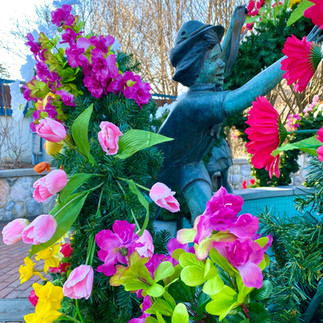Oma’s Schinkenbraten (Grandma’s Roasted Ham)
- jvannette5
- Apr 10, 2022
- 2 min read

Ingredients:
Ham - whole, half, or smaller portion ¼ - ½ cup of brown sugar (depending on size of ham) 1/8 - 1/4 cup of Bavarian mustard Pineapple pieces/juice (optional) or water 1-2 teaspoons of ground cloves 2-4 C. red wine
Directions:
Make a glaze with the mustard, brown sugar and some pineapple juice/pieces or water.
Brush a layer of this on the ham and then sprinkle with the ground cloves
Pour red wine into the roasting pan, as this will make a great basting liquid (feel free to drink the rest of the bottle yourself)
Bake at 300 degrees until internal temperature reaches 165-180 degrees
Remove from oven, let cool a bit, slice and serve
When it comes to celebrations in Germany, particularly in the Franconian region of Bavaria, colorfully decorated trees are not just for the Christmas season. Roughly four weeks before Easter, which falls on April 17, 2022 handcrafted eggs dangle from the branches of birch trees, symbolizing new life and fertility. Towns of all sizes are painted in a sea of pastel.
Public wells and fountains are elaborately adorned with greenery, garland, and Easter eggs to welcome the spring season and offer thanks for life-giving water. Each town seeks to make its decorations bigger and brighter than the next.
In 2005, the small Bavarian town of Sulzbach-Rosenberg entered the Guinness Book of World Records for the most eggs used to decorate an “Osterbrunnen,” or Easter fountain. The townspeople managed to hang a total of 16,500 eggs, beating out the previous record of 11,600 held by Baden-Wuerttemberg.
While the ornamentation comes early, the official Easter holiday in Germany begins on Gruendonnerstag (Maundy Thursday). Gruendonnerstag translates to “Green Thursday,” and it is believed to be the day on which the Last Supper was held. It is tradition to clean your house thoroughly on this day — a custom possibly linked to the preparation of a Passover Feast. Furthermore, green foods such as spinach, kale, cress, leek, chives, and other herbs, are traditionally eaten on this day.
In both American and German cultures, Good Friday is a day when Christians reflect on the crucifixion of Christ. But in Germany, the day is known as both Karfreitag meaning “sorrowful Friday” and Stiller Freitag meaning “quiet Friday.” Additionally, in Germany both Good Friday and Ostermontag (Easter Monday) are national holidays.
While there are apparent differences, many other German and American traditions overlap throughout the multi-day celebration. Easter eggs are dyed, and children anticipate a visit from the Easter Bunny, or “Osterhase.” Ostersonntag (Easter Sunday) brings church services, family gatherings complete with culinary overindulgence, rousing Easter egg hunts and baskets filled to the brim with chocolate and candy.
One uniquely German experience is the Saturday night bonfire — a symbol for the sun as the giver of life. Additionally, braided sweet bread in the shape of a wreath, or “Osterbrot,” can be found in German bakeries around the holiday.
In Saginaw County, the city of Frankenmuth, whose founders hailed from Germany’s Franconian region, celebrates some of these traditions, including the decoration of fountains and local businesses with greenery and brightly colored eggs.
This week’s ham recipe, or a close variant of it, will likely grace the table of many Frankenmuth homes on Ostersonntag.




































